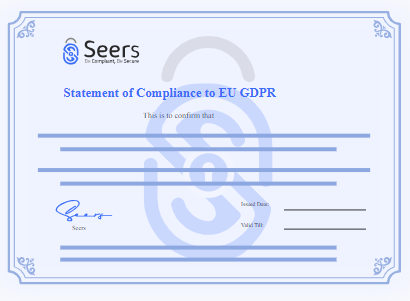The era of 2024 is all about smartness, efficiency, and awareness. Because these are the only sources through which one has the capacity to survive in this rapid-growing world. Companies and individuals must think outside the box to compete and maintain their standards. Taking suitable data privacy awareness steps is now an important necessity for everyone to maintain the compliance and stability of their organisation.
Data privacy training is all about being compliant with laws like the General Data Protection Regulation (GDPR). Ignoring these responsibilities can lead to huge fines, bad press, and lost trust. That’s why Privacy Compliance Training is essential—it helps you understand your legal duties and teaches you how to implement the right best practices.
What is meant by data privacy awareness training?
Training in data protection involves instructing people in the fundamentals of keeping personal information safe and private. In today’s digital environment, when data breaches and privacy issues are widespread, businesses must prioritise data security and provide their staff with the tools they need to be good data stewards.
Classification of data, safe data processing processes, access restrictions, encryption methods, incident response protocols, and adherence to applicable privacy rules, are only some of the subjects covered in data protection training.
The Importance of Data Protection Training
The data protection training aims to inform workers on the significance of data protection and prepare them to deal with possible dangers. And provide them with direction on implementing appropriate security measures. Investing in data protection training, which in turn promotes a culture of data security inside a business, may reduce the financial, legal, and reputational risks associated with data breaches.
Is data privacy awareness training necessary?
Indeed, it is necessary to train the company’s employees so that they can avoid such situations in the future and take appropriate measures to handle them.
- Rising Cyber Threats: Cyber threats and data breaches are becoming more frequent and sophisticated, necessitating a focus on data privacy.
- Importance of Training: Data privacy awareness training educates employees about the legal and ethical implications of data mismanagement and disclosure.
- Promoting Security and Accountability: Teaching recommended data privacy practices fosters a culture of security and accountability within organizations.
- Recognizing Threats: Training helps employees identify and avoid phishing and social engineering attacks.
- Reducing Legal Risks: Effective training ensures compliance with privacy laws like GDPR and CCPA, minimizing the risk of fines and legal action.
- Enhancing Organizational Security: Data privacy awareness training strengthens overall security, boosts consumer confidence, and protects critical data assets.
Benefits of employee awareness training
Employee awareness programmes are now gaining popularity. Every firm is now taking suitable steps to train its employees in order to maintain their standards. Training for heightened employee consciousness has many positive outcomes for workers and businesses. Some major benefits of educating workers on these issues are as follows:
| S.R | Benefit | Explanation |
| 1 | Safety Improvements | Training programmes improve security by teaching personnel proper practises. Employees learn to recognise and react to phishing and social engineering attempts. Security and data breaches decrease. |
| 2 | Controlling Dangers | Training reduces data breach, security, and compliance risks. Employees understand their roles in security and privacy and the penalties of non-compliance and they are more inclined to follow security regulations. |
| 3 | Data Management Enhancements | Proper data management and protection training is taught to staff. Classification, storage, encryption, and disposal are covered. Data loss, leakage, and illegal access are reduced. |
| 4 | Conformity with Regulations | Data privacy regulations apply to many businesses. Employee awareness training helps workers understand their legal and regulatory requirements. This protects companies against privacy violations, penalties, and brand harm. |
| 5 | Safety-Conscious Society | Organisations become security-aware through training. Employees take control of data security. Employees regularly monitor risks and report security issues in this culture. |
| 6 | Productivity Boost | When staff are well-trained and confident in their data security skills, they can operate more effectively without distractions. Training programmes provide them with the security capabilities they need to concentrate on their main duties. |
| 7 | Instilling Confidence in One’s Clientele | Employee data privacy and security awareness training promotes customer and stakeholder confidence. Data-protected companies attract and keep privacy-conscious clients. |
| 8 | Emergency Response Preparation | Incident response training is common. Employees quickly identify and report security issues. Preparedness reduces security incident damage and facilitates recovery. |
Things you should keep in mind for starting awareness programs
Prior to starting the training sessions, the companies should consider the following points to make the training more effective, smooth, and understandable for the employees:
- Definable Aims: Properly define objectives to maintain the flow of the training. Experienced trainers should be given the responsibility of training through the implementation of multiple activities.
- Audience Intended: Although all employees should attend the sessions, the main concern should be the people who have major responsibilities. Or the people who have a direct approach to the sensitive data.
- The Pertinence of Content: Create engaging material. Use real-life examples, case studies, and industry-specific situations to emphasise data security. Engage and apply the knowledge to participants’ everyday jobs.
- Exciting and Participatory Presentation: Interactive and engaging delivery approaches improve user participation and knowledge retention. Quizzes, simulations, movies, and debates promote active learning.
- Messages that are Direct and Brief: Clarify the main points. Use simple, non-technical terminology. Ensure attendees understand the training’s key points.
- Constant and repeated instruction: continuous training instead of one-time events. To maintain awareness and manage new threats, provide frequent refreshers, updates, and reinforcement—onboard new employees with the awareness program.
- Evaluation and quantitative Analysis: Measure the awareness program’s success via metrics. Assess knowledge retention and behavioural changes via feedback questionnaires, quizzes, assessments, or incident monitoring data. Evaluate and improve the program based on feedback.
- Participation and backing from the higher-ups: Demonstrate the awareness program’s value by including organisational executives. Leaders who encourage and participate in the program demonstrate the company’s commitment to data security.
- Harmonisation with Existing Practices and Procedures: Ensure the awareness campaign matches company rules, processes, and security. Connect training to regular security practices.
- Marketing and Public Relations: Promote the awareness campaign to attract participants. Promote the program’s goals, benefits, and forthcoming sessions using emails, newsletters, posters, and intranet portals.
Types of Training You Should Consider
Different training programs cater to various needs and roles within your organisation. Let’s explore some critical training types:
Data Protection Awareness Training
Data Protection Awareness Training is the foundation of a robust data privacy strategy. This training covers key concepts like personal data, processing, and individual rights. By the end of this course, you will be equipped to identify personal data and understand the implications of mishandling it.
Cybersecurity Awareness Training
It’s not just about privacy—Cybersecurity Awareness Training is just as important. Cyber threats like phishing and malware are constant, and you need to know how to spot them before they turn into a big problem. This type of training helps you secure both personal and company data from hackers.
Specialised Training for Various Roles
Different teams in your company need different levels of training. Here’s a breakdown of specialised training courses tailored to specific roles:
- Data Privacy Training for IT Staff: This training focuses on secure data storage, access controls, and overall system security.
- Data Privacy Training for HR: This training teaches how to handle sensitive employee information while staying compliant with laws.
- Data Privacy Training for Management: Ensures leaders know how to create a culture of compliance across the company.
- Data Privacy Training for Sales and Marketing: Data Privacy Training for Sales and Marketing covers how to ethically manage customer data and ensure you’re not violating privacy rights.
Employee Data Privacy Responsibilities
Everyone in your company needs to understand their data privacy responsibilities. This means following company policies, reporting any potential data issues, and treating all sensitive information with care. Knowing your Employee Data Privacy Responsibilities ensures that everyone in your organisation understands their part in safeguarding information.
Preparing for Data Breaches
Even with the best plans, data breaches happen. That’s why it’s essential to have a Data Security Incident Response Plan in place. This should include:
- Immediate Containment: Quickly stop the breach and prevent further damage.
- Notification: Inform affected parties and regulatory bodies as required by law.
- Investigation: Figure out how the breach happened, fix any vulnerabilities, and put safeguards in place to prevent it from happening again.
Training for Incident Response
Including Data Breach Prevention Training in your privacy plan can help employees spot potential risks before they turn into full-blown breaches.
Embracing GDPR Employee Training
Breaking down the regulation necessary for data protection in Europe, the GDPR pays particular focus on training of employees. The GDPR Employee Training is more specific regarding your individual and company responsibility in accordance with the GDPR regulation for data protection of individuals’ rights.
To access overall GDPR staff e-training resources, consider Seers. It provides customized online training solutions to assist employees and enforce the GDPR compliance guidelines. You can explore its offerings here.
Seers Your Trusted Partner in GDPR Staff Training
What We Offer:

- Quick Online Training: Complete the GDPR training in just 45 minutes.
- Training Certification: Receive a GDPR Training Certificate upon completion to prove compliance.
- Customizable Programs: Tailored training that fits the unique needs of your team.
- Ongoing Support: We provide continuous assistance to help you stay compliant.
Ready to empower your team with essential GDPR knowledge?
Book Youe Demo NowPromoting Privacy Rights Education
Data Privacy Rights Education is an essential component of your training. You should be aware of your rights under data protection laws, including the right to access, rectify, and erase your personal data.
Advanced Training Opportunities
As data privacy continues to evolve, so should your training. Explore advanced courses such as:
-
- Sensitive Data Protection Training:Get to know how to manage very confidential information, such as the health information.
-
- Data Privacy Training for Data Analysts: Understand how to analyse data while staying compliant with privacy laws like GDPR and CCPA.
-
- Data Privacy Training for Developers: Learn to integrate privacy into the software development lifecycle.
Tailored Options for Different Audiences
Everyone agrees that data privacy training should be mandatory but what works for one company may not necessarily work for another. Cross functional teams may have different issues and your training has to address them. Let’s break it down:
-
- Small Businesses: For smaller companies, resources and manpower are generally limited. Essentially, training that is required here needs to be focus on simple, actionable steps that don’t break the bank. The aim is to remain compliant with minimal hassle.
-
- Large Enterprises: Bigger companies face complex systems and deal with more teams. Training for large organizations should cover everything from managing multiple departments to navigating global compliance rules. It’s about making sure everyone, from top to bottom, knows their role in keeping data secure.
-
- Remote Workers: As more people work from home, keeping data secure outside the office is a growing concern. This training helps remote employees understand how to protect sensitive information, whether they’re working from home, a coffee shop, or anywhere else.
Engaging Online Training Solutions
Online data privacy training gives flexibility in the today’s busy world. The training is flexible in that you can complete them at your own time and therefore train at your own pace.Many organisations, like Seers, offer data privacy training courses that cover various topics, ensuring that you get the one you want.
Best Practices for awareness training:
Training Needs
Conduct an evaluation to determine the particular training requirements of your firm before developing a data security training program. Assess the functions and divisions responsible for handling sensitive data, identify knowledge gaps, and learn about the level of awareness staff have about data security.
Job-Specific Training
Create specialised training courses that address the needs of employees in various departments and positions. Supplying employees with content tailored to their data security needs may increase engagement and productivity.
Data Security Topics
Classification of data, access restrictions, encryption, safe data handling, incident response processes, and legal and regulatory requirements are all important components of a comprehensive data protection training program. The staff may then understand the whole range of data protection procedures.
Case Studies and Real-Life Examples
Case studies and real-world examples should be used to demonstrate the effects of data breaches and the significance of data security. Employees get a feeling of duty and urgency when they are provided with real-world examples of the negative outcomes that might result from lax data security measures.
Encourage Interactivity
Use active learning techniques to get staff interested in training. Use activities like tests, simulations, role-playing games, and class debates to cement concepts and get students involved. Interactive elements significantly improve employees’ ability to remember information and apply data security concepts in real-world situations.
Update Training Regularly
It is essential to give frequent training updates to keep staff aware of emerging dangers and new data security procedures since data protection practises and technology advance at a fast pace. Schedule regular training sessions or offer access to regularly updated online resources to guarantee that learning is ongoing.
Foster Vigilance
Encourage everyone in your company to be vigilant about protecting sensitive information. Motivate your staff to disclose any security issues, suspicious behaviour, or vulnerabilities immediately. Reinforce a shared responsibility for data security by rewarding and acknowledging those who go above and beyond in their data protection efforts.
Measure Training Effectiveness
Incorporate analytics into your data security training program to see how well it performs. Assess workers’ knowledge retention and behaviour changes via feedback questionnaires, quizzes, or practical assessments. You should study the data regularly to spot problem areas and adjust your training appropriately.
Conclusion
Investing in Data Privacy Awareness Training is crucial for your organisation’s success. By understanding the significance of data privacy, embracing training tailored to your role, and implementing best practices, you contribute to a culture of privacy and compliance.
As you move forward, remember that data privacy is not a one-time task but an ongoing commitment. Equip yourself and your colleagues with the knowledge and tools to protect sensitive information, ensuring your organisation thrives in a secure environment.
FAQs
Why is it important for all staff to have GDPR training?
GDPR training is essential for all personnel. First, the GDPR is a strict data protection law. It applies to EU enterprises and non-EU organisations that handle EU citizen data. Organisations guarantee GDPR compliance by educating all personnel.
Why is it important to be aware of data privacy?
Data privacy awareness protects rights, prevents identity theft, builds confidence, mitigates data breaches, and complies with rules. Understanding data privacy and taking safeguards may help protect personal data and create a more secure and privacy-conscious digital environment.
What are the data protection tips for employees?
Employees should bear in mind the following data protection guidelines:
1. Effective Passwords
2. Phishing Education
3. Phishing Education
4. Risk-Free Hardware
5. Safer Wireless Networks

